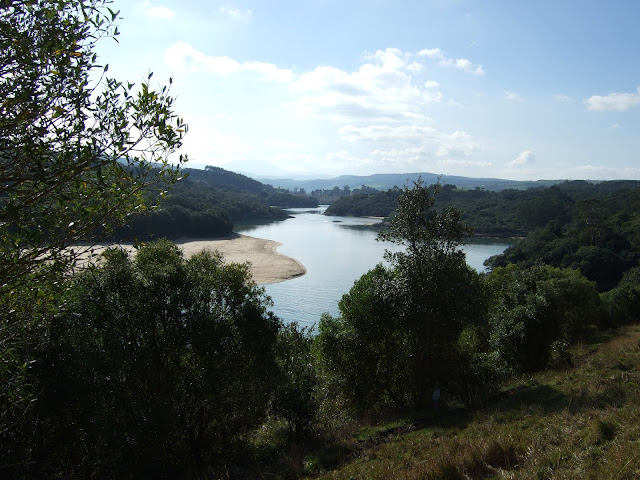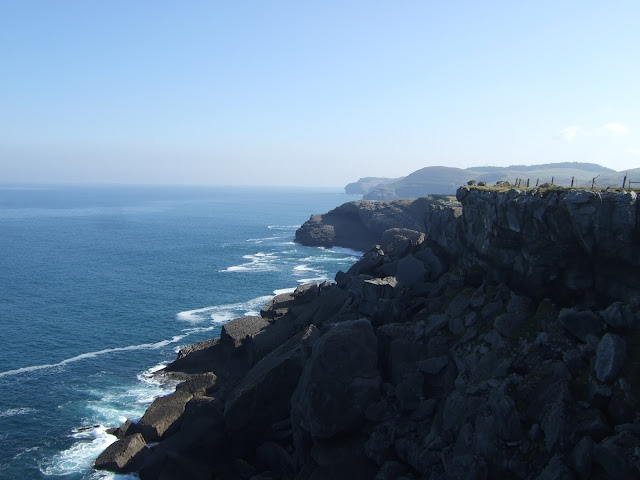I chose a mountain walk in east Cantabria to test my knee. Leaving the town of Ramales we crossed the river Gándara and followed it upstream to the south. Another lovely sunny day in store.
Vamos a la izquierda, siguiendo el río, continuando por la izquierda en un cruce, viendo el Pico San Vicente a nuestra derecha. Se bordea por la izquierda antes de acometer la subida final.
I last went up Pico San Vicente about 20 years ago, but this time the starting point was lower down. The walk was to take us round to the left on the mountain before beginning the final ascent.
Hay que estar atentos cuando empezamos a subir por una pista, para coger un sendero a la izquierda donde está indicado Manzaneda (abajo a la izquierda aparece una piscifactoría), y bajamos para ponernos a las orillas del río.
The path starts to go up but almost at once you take a signposted path to Manzaneda to the left (below to the left there's a fish farm) and go back down to the river bank.
Entramos en un encinar y empezamos a ganar altitud
We then entered a holm oak wood and the walk was uphill from there on.
En un punto hay una cueva donde se podría imaginar perfectamente a los del Clan del Oso Cavernario. A través de una "ventana" en la roca vemos la Peña Busta hacia el este
At one point there's a cave which I could perfectly imagine the Clan of the Cave Bear inhabiting. Through a gap in the rocks you can see Peña Busta to the east
Salimos del bosque y vemos la zona entre los Tornos y La Sía en frente
We come out of the woods and enjoy the view to the south.
Ahora tenemos una perspectiva distinta del Pico que vamos a subir
The mountain looks quite different from the side.
Entramos en el barrio de Manzaneda y empezamos la última parte de la excursión, siguiendo una flecha al lado de "La casa del Lirón"
We begin the last part of the climb in Manzaneda, following an arrow that points north.
Poco a poco se hace más empinado
It gets steeper and steeper
Pero la recompensa son las vistas desde arriba. A nuestros pies está Ramales y el Buciero de Santoña más allá en la costa.
But the reward is at the top, with this view of Ramales down below and Santoña on the coast.
La Peña del Moro a la izquierda, y en el horizonte se intuyen Anboto y Gorbeia
To the left of Peña Busta is Peña del Moro and Basque mountains Anboto and Gorbeia on the horizon.

Soba - los montes nevados de la derecha serán Imunia y Peña Lusa, con Castro Valnera detrás y el Picón del Fraile a la derecha
The view to the southwest
a continuación La Sierra del Hornijo
and round to the west.
Before going back down I took another photo where you can see the first part of the walk, with the field with yellow flowers and then the fish farm between the gap in the rocks.
tardé la mitad en bajar que subir - la verdad es que ¡noté mucho la inactividad de las últimas semanas!
It took only half as long to get back down to Manzaneda as going up had taken. I can tell you I really noticed the layoff!
Mi idea original era buscar un camino que me llevara al Humilladero de la Canal para luego volver a Ramales por la GR-74, pero no lo encontraba y además, no apetecía mucho andar por pista bajo el sol, así que volví a Manzaneda y bajé otra vez por el bosque. La foto muestra Pico San Vicente desde el SO.
I had originally planned to head west and pick up the GR-74, but couldn't find the path, and anyway, the idea of following a trail in the hot sun (I kid you not) didn't appeal especially so I turned back to the wood again. The photo shows Pico San Vicente from the SW.
Ya estamos otra vez donde el campo de flores amarillas, que puede ser canola o colza (no sé bien cómo se dice)
Back beside the river. I don't know whether this is rapeseed or not.
El sol quedaba por detrás del Pico
The sun was now behind the peak.
Y para acabar, cuando llegué a Ramales decidí echar un vistazo al lugar donde se juntan los ríos Gándara y Asón, ya que me ha dado por ahí últimamente. He añadido más fotos en la entrada correspondiente de enero
Y ¿la rodilla? bien gracias.
I'm pleased to report that my knee survived the ordeal OK.













































